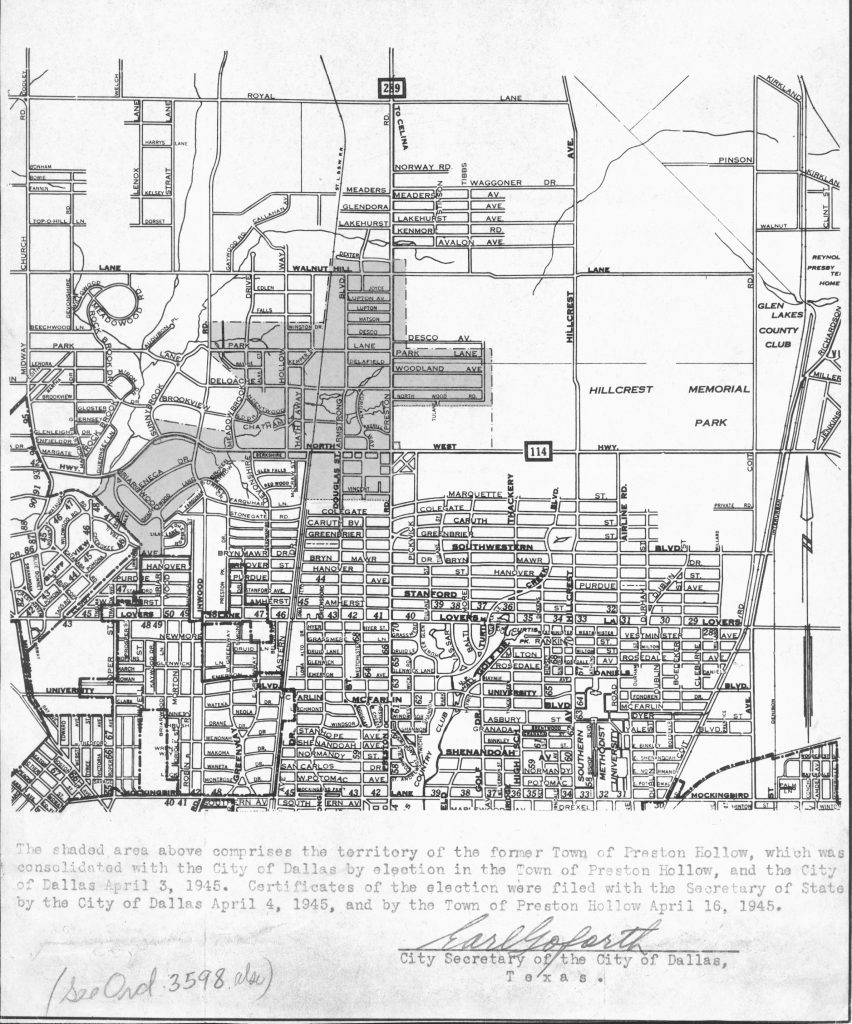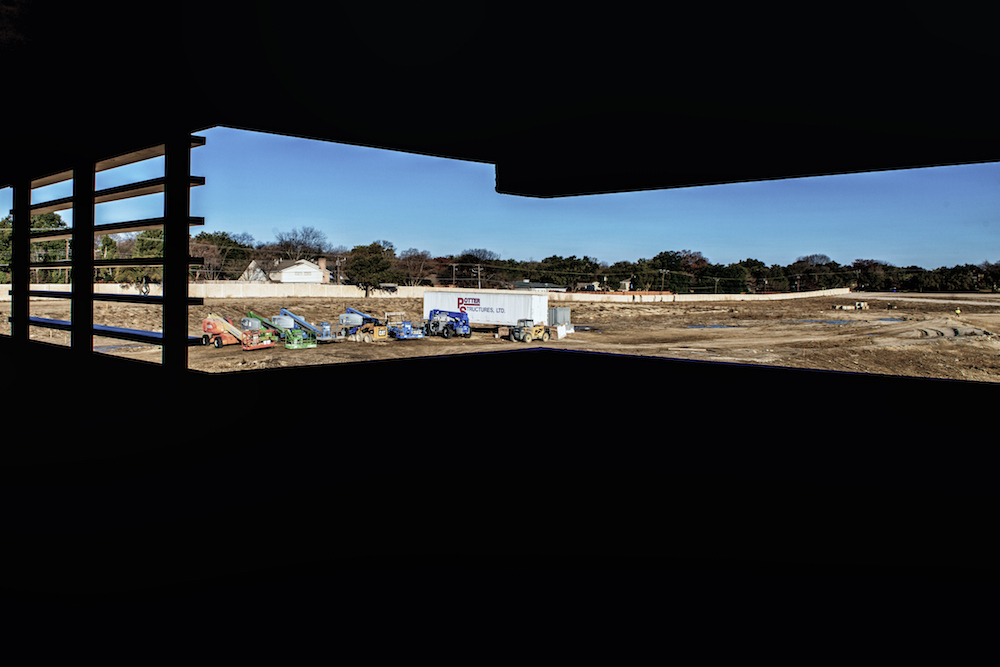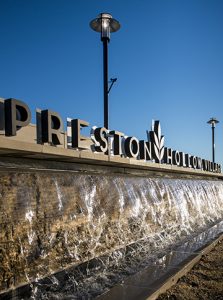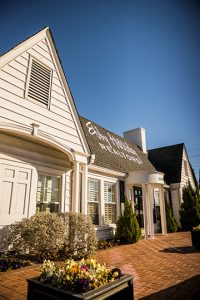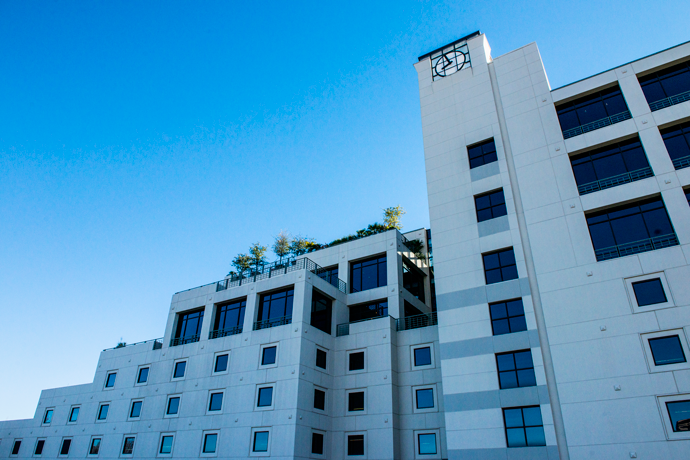
Preston Center office tower: Photo by Danny Fulgencio
There is no official map of Preston Hollow — not since the two-square-mile makeshift municipality was annexed to the city in 1945. But we know the neighborhood by its sprawling estates, bar-ditch roads, upscale shopping and famous residents. When former President George W. Bush moved to Daria Place in 2009, suddenly everyone knew Preston Hollow. But where is it, really? And, if geographical boundaries don’t define it, then what does?
How we got here
Compared to the older, urban parts of Dallas, our neighborhood is far from historic. But there is a history, one often overlooked even by residents. After all, about half of the original ranch-style homes have been torn down and replaced by million-dollar mansions. Preston Hollow appears shiny and new.
“They have no idea,” says Lydia Player, a longtime Realtor who has lived in Preston Hollow for 30 years. “I don’t think people know the history at all.”
When Dallas began to grow in the first half of the 20th century, prospective homeowners flocked south to Oak Cliff, east to Lakewood and north to the Park Cities. Then came Ira DeLoache, a cigarette salesman-turned-developer who in 1923 bought a 56-acre tract at the northwest corner of Preston and Northwest Highway, outside the city limits, and began platting country homes on large one-acre lots.
Throughout the 1930s, other well-known developers came in and built extravagant homes, some of which remain today. But according to Peter Flagg Maxson’s section in “Legacies: A History Journal for Dallas and North Central Texas” published in 2002 by the Dallas Historical Society, Preston Hollow’s early residents constituted more than wealthy landowners.
“While today Preston Hollow has a very wealthy populace, historically it was more mixed economically,” Maxson writes.
“There were unquestionably some very wealthy people living there with mansions, Packards, private schools and debutante daughters. But there was also a thriving middle class who built three-bedroom homes, sent their children to public schools and drove Studebakers.”
By the late 1930s, continued development prompted the need for city services, which the area could not receive being located so far outside the city limits of Dallas. There was no zoning, no police or fire departments, no garbage collection. Preston Hollow residents also valued their independence, Maxson notes. In 1939, they voted to incorporate, and Preston Hollow became its own city with 887 residents covering about two square miles.
[quote align=”right” color=”000000”]“With each demolition, significant links with early Preston Hollow are lost.”[/quote]The uneven boundaries extended roughly from Northwest Highway to Walnut Hill and Meadowbrook to Preston, along with a small area that jutted to the east. It also included what is known as Briarwood just south of Northwest Highway and west of Inwood.
City Hall was established at the white frame house still standing today at Preston and Northwest Highway, now serving as an office for Ebby Halliday Realtors. It also was the site of the town’s only stoplight. The first orders of council business included a zoning ordinance, limitations on horse stables and lot size restrictions. However, the town never produced enough revenue to provide the services it originally sought, functioning almost entirely on volunteers.
In 1945, amid opposition from some residents who did not want to pay property taxes, the majority voted to absorb Preston Hollow into the City of Dallas.
Development surged through the 1950s and ’60s but eventually, so did redevelopment. Maxson laments the teardown trend, writing, “With each demolition, significant links with early Preston Hollow are lost.”
What attracted the original residents, though, still proves true for today’s homeowners. People like the suburban country feel, the large lots, wooded creeks and tall trees. Add the convenient access to shopping and freeways, and you’ve got some of the most valuable land in the city — where bulldozing a mid-century modern house is met with a shrug.
“You’ve got a lot of teardowns,” says Dallas City Councilman Lee Kleinman, who lives in one himself, off Northaven. “That would not be tolerated as much in East Dallas. You don’t get that here.”
A few major works have been preserved, such as the Crespi Hicks estate, originally constructed in 1939 for an Italian Count, at 5555 Walnut Hill. Preston Hollow also boasts many modern homes from Frank Lloyd Wright’s only residential project at 9400 Rockbrook, built in 1958, to Lionel Morrison’s starkly contemporary home at 5753 Berkshire, built in 2003.
While these days Preston Hollow may not be known as historic, its architecturally significant homes have become its chief identifier. But it still leaves the nagging question: Where is Preston Hollow? It depends on whom you ask.
Where we are
The annexation of Preston Hollow came just in time for the post-World War II movement that attracted homeowners to the suburbs. As Dallas continued to grow north, the boundaries of the original Preston Hollow became somewhat lost.
“I think the whole expansion started because the property values were so high, and more people wanted to be a part of that,” says Lori Sparks, a Virginia Cook Realtor and lifelong neighborhood resident.
Growing up in the 1970s in Russwood Acres, off Inwood between Royal and Northaven, Sparks says no one even called the neighborhood “Preston Hollow” — not even those in the original core farther south.
“Back then, we’d say North Dallas,” Sparks says. “We wouldn’t say ‘Preston Hollow.’ It’s become very chic because of the estate properties.”
Those sites lie within the area identified as Old Preston Hollow: Northwest Highway to Walnut Hill and Preston to Midway. Purists might say this is Preston Hollow and other geographic boundaries are incorrect. But most residential real estate experts agree on a slightly broader definition: Northwest Highway to Royal and Hillcrest to Midway. People want to be associated with beautiful homes and celebrity neighbors, so agents often find ways to mention the name even if a home lies just outside the perimeter, says Player, who has been selling homes for decades with Ebby Halliday Realtors.
“The funny thing we like to joke about as real estate agents is that when we’re selling a house, we say it’s in ‘the vicinity of Preston Hollow’ or ‘the Preston Hollow area,’ ” Player says. “You want to use those words in the description because it’s appealing to buyers.”
It’s appealing to developers, too.
Leon Backes, president of Provident Realty Advisors, is responsible for the new mixed-use shopping center at the northwest corner of Walnut Hill and Central, calling it Preston Hollow Village. The shopping center, 10 years in the making, “named itself,” he says. Even after branding companies came up with plenty of suggestions, people were already calling it Preston Hollow Village, and the name stuck.
[quote align=”right” color=”000000”]“Back then, we’d say North Dallas. We wouldn’t say ‘Preston Hollow.’ It’s become very chic because of the estate properties.”[/quote]“It’s a state of mind,” he jokes, when asked where Preston Hollow actually is. His estimate is more generous: LBJ Freeway to Northwest Highway and Hillcrest to Midway. But, he concludes, “I don’t think there are any boundaries.”
The shopping center houses a Trader Joe’s and a slew of hip restaurants new to the Dallas market. Backes, who also lives nearby, says the name is appropriate because the development aims to serve Preston Hollow residents. He doesn’t claim that it’s actually in Preston Hollow (although, who’s to say?).
“Putting Preston Hollow in the name increases the marketability,” Player says. “The corner of Walnut Hill and Central Expressway is not Preston Hollow.”
So, where does the name-dropping end? Neighbors have questioned the new Preston Hollow Emergency that recently opened on the east side of Central, complete with a jumbo red sign displaying the words, “Preston Hollow.”
The company’s marketing director, Cortney Rodriguez, says our neighborhood is one of the target markets for the 24-hour upscale ER.
“We felt we were right on the cusp of Preston Hollow, especially with Preston Hollow Village opening across the highway from us,” Rodriguez says.
While the residential real estate community takes a more exclusive approach, the commercial real estate community paints Preston Hollow in much broader strokes. It’s no wonder that the average homeowner hesitates to claim the neighborhood name. Many neighbors describe where they live by their street name, “off Boedeker,” or a reference point, “behind St. Mark’s” or just the catchall term, “North Dallas,” as it was 30 years ago.
“I don’t really hear Preston Hollow being tagged like Lakewood,” says Carol Short, vice president of public affairs for the North Dallas Chamber of Commerce.
That’s probably because Short’s definition of Preston Hollow is the broadest of them all: Northwest Highway to LBJ and Central to Marsh.
She grew up on Azalea from the late-1950s to the mid-1970s, just a few blocks north of Royal — an area Realtors would call “the vicinity of Preston Hollow.”
Short remembers playing on the railroad tracks that eventually became the Dallas North Tollway — one of the early initiatives of the chamber after it formed in 1954, united under the push to pave Preston northward.
As Dallas continued to grow, the chamber stopped claiming boundaries for its membership. Its members now hail from all over the city and neighboring suburbs, and a typical meeting features presidents and CEOs from major banks, law firms, utility companies and restaurant groups.
“We’ve got members in Irving and Plano and Richardson,” Short says. “We’re very supportive of development in South Dallas because it takes the tax burden off of North Dallas. We want to see all of Dallas prosper because not only does it bleed into other parts of town, but it evens out the tax base.”
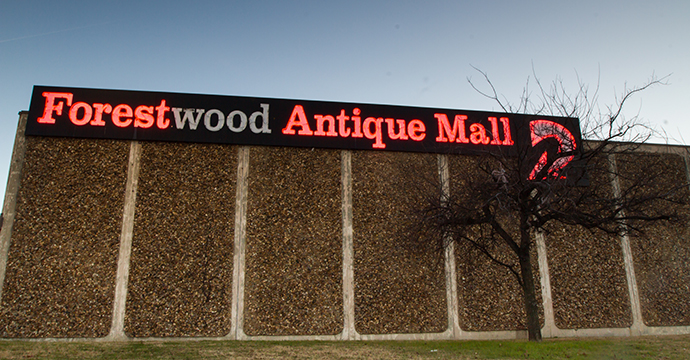
Some say the northeast corner of Forest and Inwood, which includes the Forestwood Antique Mall and other well-known establishments, represents the northern boundary of Preston Hollow. Photo by James Coreas
What defines us
Dallasites are perhaps more aware of our city’s neighborhoods than in previous decades. We are no longer simply north or south.
“People are trying to break down the size of the city by affiliating with the neighborhood,” Kleinman says.
And each has its own identity, which tends to originate from a cohesive push for improvement. Lakewood and East Dallas activists have mobilized to protect White Rock Lake and transform Lower Greenville. Oak Cliff leaders have rebranded a once discarded area through historic preservation and creative urban design, making the Bishop Arts District an entertainment and dining destination. Lake Highlands residents join in hopes of resolving issues such as infrastructure at Skillman and LBJ, crime hotspots, and a lack of retail. These neighborhoods and their landmarks are represented on T-shirts and coffee mugs and wall art. The Lake Highlands business community even outsourced a firm to create a neighborhood brand and logo.
Why isn’t Preston Hollow like that? Herein lies the difference: Other neighborhoods have formed their identities by reinventing themselves at some point and are, perhaps, still reinventing themselves. Preston Hollow is and always has been defined simply as a desirable place to live. It has good home values, the top private schools, quality grocery stores, plenty of neighborhood restaurants and services, and convenient access to other parts of the city. Aside from what attracts homebuyers, people are not united under one identity.
“I don’t think that’s important,” says Dallas City Councilmember Jennifer Staubach Gates. “They go there for those reasons. They don’t feel like they’re rallying around the cry of ‘We’re in Preston Hollow.’ They might describe where they live as Preston Hollow, but it’s not like there’s a mascot.”
Cynthia Langhorst and her young family recently moved from the M Streets to Preston Hollow East (for all of the above reasons), and she’s on the board of the Preston Hollow Early Childhood Association. The SMU alumna doesn’t know much about the boundaries of the neighborhood, except that, “it does seem to keep spreading.” Things were different in her native city of Chicago.
“Chicago has very defined neighborhoods,” she says. “Each neighborhood is its own thing. You know when you’re in Lincoln Park. Dallas is spread out. It’s not a walkable city, except for parts of Greenville Avenue.”
That, she says, makes it hard to identify with Preston Hollow as a neighborhood. It has landmarks, but like the boundaries, those are debatable, too. The Inwood Theater and Preston Center are ours, but they could just as well belong to the Park Cities. The iconic 1970s-era mural along Forest Lane is arguably not in Preston Hollow. That leaves possibly the Jewish Community Center, Town North YMCA, Preston Royal Library and retail signage for Preston Royal Village or Dougherty’s Pharmacy.
Many neighbors rally around their faith communities. Preston Hollow Presbyterian Church and Temple Emanu-El are just a couple of the longstanding houses of worship that produce topnotch musical programs and act as neighborhood gathering places.
[quote align=”right” color=”000000”]”They don’t feel like they’re rallying around the cry of ‘We’re in Preston Hollow.’ They might describe where they live as Preston Hollow, but it’s not like there’s a mascot.”[/quote]
Still, there is something missing from the Preston Hollow puzzle that could contribute to our sense of community — public green space.
“I think we’re welcoming, but there’s not an abundance of parks where people are congregating,” Gates says.
That began to change with the construction of the Northaven Trail, though not in Preston Hollow proper, according to some. It runs from Lavendale to Preston and last fall received a $2.5 million grant from the North Texas Council of Governments to extend west to the Walnut Hill/Denton Drive DART Station. The Friends of the Northaven Trail have come together to provide trail enhancements and organize community events. In April, the group is hosting its first-ever 5k run.
Kleinman and Gates are working to find funding for a temporary dog park at Forest and Nuestra (see more on page 9).
“I think people want to be a part of good things going on,” Kleinman says. “People want a place to meet. They want to engage.”
While the question, “Where is Preston Hollow?”, may continue to confound neighbors, arriving at a clear answer isn’t all that important in the end. Residents are too busy enjoying their new homes, big yards and shopping destinations to worry about what to call this collection of neighborhoods.
“That’s a better description for it,” Gates says, “a collection of neighborhoods. We’re talking about a pretty vast area that we’re trying to call Preston Hollow, so you’re not going to have that kind of cohesiveness.”
And that’s OK.
“It’s a description of their community, and then they make their neighborhoods vibrant and active.”
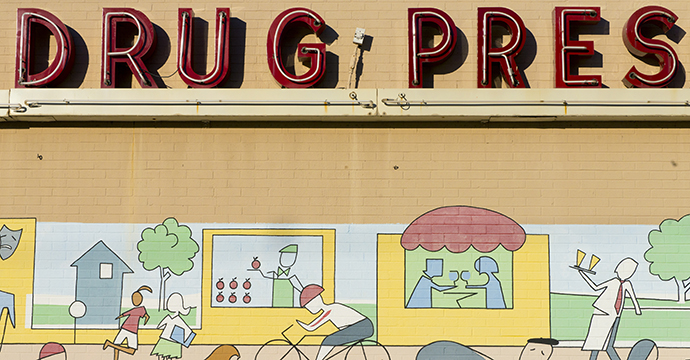
The Dougherty’s Pharmacy neon sign, along with the mural painted in 2008, is a neighborhood landmark to some. Photo by Danny Fulgencio
Let’s ask some experts: Where is Preston Hollow?
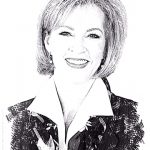 Lori Sparks is a Realtor for Virginia Cook and a lifelong neighborhood resident. She grew up in Russwood Acres near Royal and Inwood and graduated from Hockaday.
Lori Sparks is a Realtor for Virginia Cook and a lifelong neighborhood resident. She grew up in Russwood Acres near Royal and Inwood and graduated from Hockaday.
“What I kind of use in real estate is, if these homes are tied to Preston Hollow Elementary, I think that’s totally fine. That does include homes east of Hillcrest.”
 Cynthia Langhorst is a board member of the Preston Hollow Early Childhood Association. The Chicago native moved to Dallas to attend SMU and eventually settled in Preston Hollow.
Cynthia Langhorst is a board member of the Preston Hollow Early Childhood Association. The Chicago native moved to Dallas to attend SMU and eventually settled in Preston Hollow.
“It depends on who you ask. Going to SMU, I felt like it was Northwest Highway to Walnut Hill to the Tollway to Hillcrest. It does seem to keep spreading.”
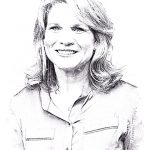 Jennifer Staubach Gates is the District 13 City Councilmember, representing all of what was historically known as Preston Hollow. Parts of her council district extend to LBJ Freeway and past Webb Chapel. Gates actually grew up in Far North Dallas near Hillcrest and Alpha, but attended Ursuline Academy and now lives in Royal Northaven.
Jennifer Staubach Gates is the District 13 City Councilmember, representing all of what was historically known as Preston Hollow. Parts of her council district extend to LBJ Freeway and past Webb Chapel. Gates actually grew up in Far North Dallas near Hillcrest and Alpha, but attended Ursuline Academy and now lives in Royal Northaven.
“Growing up in the area, I felt like it was much more concentrated. I think it is defined in loose terms today. Even as far west sometimes as Midway and as far east as Hillcrest. Maybe even as far as Central. Some people consider north as far as Forest Lane. I don’t think of myself as living in Preston Hollow, and I live between Inwood and Midway.”
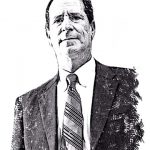 Lee Kleinman is the District 11 City Councilmember, representing the rest of our neighborhood north of Royal, and extending into Far North Dallas. He grew up on Alta Vista, attended St. Mark’s and now lives off Northaven.
Lee Kleinman is the District 11 City Councilmember, representing the rest of our neighborhood north of Royal, and extending into Far North Dallas. He grew up on Alta Vista, attended St. Mark’s and now lives off Northaven.
“I always thought it was Northwest Highway to Royal and Hillcrest to Preston. I affiliate it so much with Preston Road.”


